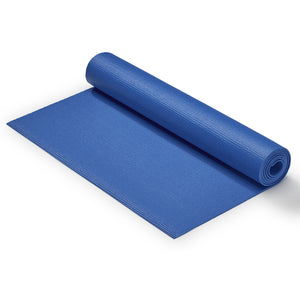April is recognized as National Stress Awareness Month and is used to bring attention to the negative impact of stress. This can act as a reminder to prioritize our mental well-being and explore effective strategies for managing stress(1). Managing stress is an essential component of a healthy lifestyle. As we navigate the complexities of modern life, stress has become an ever-present companion for many. In this article, we'll explore the various tips, techniques, and resources to help you navigate stress more effectively.
Understanding Stress
Before diving into stress management techniques, it’s crucial to understand what stress is and how it impacts our lives. Stress is the body’s natural response to pressure or threats, whether they are real or perceived.(2) The stress response, often referred to as the "fight-or-flight" response, is orchestrated by the autonomic nervous system and the endocrine system.(3) When we encounter a stressor, the brain perceives it as a threat through nerve and hormonal signals.(4) This prompts the adrenal glands, found atop the kidneys, to trigger the release of stress hormones, such as adrenaline and cortisol.(5) These hormones prompt a cascade of physiological and psychological reactions, including increased heart rate, elevated blood pressure, and heightened alertness, all designed to mobilize resources and prepare the body to confront or flee from the perceived threat.
Types of Stress
Stress can be categorized into two main types: acute stress and chronic stress.(6) Acute stress is short-term and typically results from immediate stressors, such as a traffic jam or a disagreement with a colleague. While acute stress is a natural and adaptive response, chronic stress is more insidious and occurs when stressors persist over an extended period of time. Some examples of chronic stress include ongoing financial difficulties, relationship problems, or work-related stress. While some stress can be motivating, chronic stress can have profound implications for physical and mental health, contributing to a host of issues, including anxiety, depression, cardiovascular disease, immune dysfunction, and various physical ailments.(7)
Understanding Stressors
Stressors, the triggers of stress, can vary widely from person to person and situation to situation.(8) What one individual perceives as stressful, another may view as manageable or even exhilarating. Common stressors include work pressures, financial worries, relationship conflicts, major life changes, and environmental factors. Additionally, internal stressors, such as perfectionism, negative self-talk, and unrealistic expectations, can exacerbate stress levels.
Techniques for Stress Management
1. Recognize Signs of Stress
Your body often sends signals when it is stressed. This might show up in the form of headaches, cold hands, upset or nervous stomach, tight muscles, clenched teeth, difficulty concentrating, feeling on edge, shallow breathing, fidgety movements, or feeling irritable and withdrawn. The first step is tuning in to how your body communicates that it is stressed. This changes from person to person and the signals may be subtle or exaggerated depending on your body.(9)
2. Acknowledge Your Feelings and Sensations
Once you learn to recognize the signs, sometimes it can be helpful to name or label the feelings or sensations, either to oneself or to a friend. Feelings can happen simultaneously. So you may feel sad, angry, irritable, and confused all at once. Become aware of the many feelings, and without judgment, accept them as they occur. Whatever feelings that you are experiencing, know that it's okay. Tuning into the sensations your body is experiencing might give you more insight into what you are feeling and why.(10)
3. Track Your Thinking
Most of the time our thoughts don’t stop. They may even be moving so fast that we don’t know how they are affecting our stress levels. Practice slowing down to notice your thought patterns. We all have thoughts that are unhelpful. So if you pay attention to your thinking patterns, you can then engage in changing the pattern to more helpful thinking.(11)
4. Reframe the Problem
Experts call changing the way we think about and respond to stress “reframing.” Positive reframing is a powerful psychological technique that involves changing the way we perceive and interpret challenging situations. Instead of dwelling on the negatives, positive reframing encourages us to adopt a more optimistic outlook, focusing on the opportunities for growth and learning embedded within adversity. At its core, positive reframing is about shifting our perspective from one of defeat to one of resilience and empowerment. Rather than seeing obstacles as insurmountable barriers, we view them as temporary setbacks that can ultimately lead to personal development and success. Keeping situations in perspective is an important way to boost stress resilience.(12)
5. Take Action to Counter the Effects of Stress
There are many helpful strategies to help induce relaxation and reduce tension.
Practical Strategies for Managing Stress
Practice Mindfulness
Incorporate mindfulness practices into your daily routine, such as meditation, mindful eating, mindful movement, walking meditation, and sensory exercises. These techniques can help you stay grounded and present, reducing the impact of stressors.(13)
Engage in Relaxation Techniques
Some include meditation, deep breathing, body scan, progressive muscle relaxation (Practice tensing and relaxing different muscle groups to release physical tension and promote relaxation), and repetitive prayer.(14)
Prioritize Self-Care
Make self-care a non-negotiable part of your routine. Engage in activities that bring you joy and relaxation, whether it's taking a nature walk, indulging in a hobby, or simply enjoying a warm bath. Give your mind and body a break.
Set Boundaries
Learn to say no to activities or commitments that overwhelm you. Setting boundaries is essential for preserving your mental and emotional well-being.
Stay Active
Regular physical activity is a powerful antidote to stress. Incorporate exercise into your daily schedule, whether it's a brisk walk, a workout session at the gym, or a dance class. Studies have also found that yoga, tai chi, and qigong are powerful movement-based practices that can significantly reduce stress. These three ancient arts combine rhythmic breathing with a series of postures or flowing movements. The physical aspects of these practices offer a mental focus that can help distract you from racing thoughts.(15)
Connect with Others
Cultivate supportive relationships with friends, family, or a support group. Sharing your feelings with others can provide comfort and perspective during stressful times. Don't hesitate to reach out for support when needed. Whether it's confiding in a trusted friend, seeking guidance from a mental health professional, or accessing community resources and support groups, asking for help is a sign of strength, not weakness.(16)
Practice Visualization or Guided Imagery
Close your eyes and visualize yourself in a peaceful and calming environment, such as a serene beach or a lush forest. Immerse yourself in the sensory details of this mental oasis to ease stress. You can find free apps and online recordings of calming scenes—just make sure to choose imagery you find soothing and that has personal significance. The SunnyFit® App has various guided meditations and visualizations that can help you get started.(17)
Journaling
Keep a journal to track your thoughts and emotions. Writing can help you gain insight into your stress triggers and develop effective coping strategies.(18)
Resources for Support
Therapy and Counseling
Consider seeking professional help from a therapist or counselor if you're struggling to manage stress on your own. Therapy can provide valuable tools and support for navigating stressors.
Apps and Online Resources
The SunnyFit® App offers a De-Stress Essentials collection for guided practices and stress-relief techniques.
Community Support Groups
Connect with local or online support groups focused on stress management and mental health. Sharing experiences and strategies with others can be empowering and validating.
Hotlines and Helplines
If you're in crisis or need immediate support, don't hesitate to reach out to hotlines or helplines staffed by trained professionals who can offer assistance and guidance.
In conclusion
Stress Awareness Month serves as a reminder to prioritize our mental well-being and equip ourselves with tools and resources for managing stress effectively. By implementing these tips, techniques, and seeking support when needed, we can navigate life's challenges with resilience and grace. Remember, you're not alone, and help is always available.


1. National Institute of Health. (n.d). National Stress Awareness Month. National Institute of Health. https://hr.nih.gov/working-nih/civil/national-stress-awareness-month#:~:text=April%20is%20recognized%20as%20National,component%20of%20a%20healthy%20lifestyle. Accessed 27 Mar 2024.
2. World Health Organization. (2023, February 21). Stress. World Health Organization. https://www.who.int/news-room/questions-and-answers/item/stress. Accessed 27 Mar 2024.
3. LeBouef T, Yaker Z, Whited L. Physiology, Autonomic Nervous System. (Updated 2023 May 1). In: StatPearls (Internet). Treasure Island (FL): StatPearls Publishing; 2024 Jan-. Available from: https://www.ncbi.nlm.nih.gov/books/NBK538516/. Accessed 27 Mar 2024.
4-5. Mayo Clinic. (2023, August 1). Chronic stress puts your health at risk. Mayo Clinic. https://www.mayoclinic.org/healthy-lifestyle/stress-management/in-depth/stress/art-20046037#:~:text=Understanding%20the%20natural%20stress%20response&text=Through%20nerve%20and%20hormonal%20signals,and%20gives%20you%20more%20energy. Accessed 27 Mar 2024.
6. University of Central Flordia Health Services. (n.d.). Acute vs. Chronic Stress. University of Central Flordia Health Services. https://ucfhealth.com/our-services/lifestyle-medicine/acute-vs-chronic-stress/. Accessed 27 Mar 2024.
7. Yaribeygi H, Panahi Y, Sahraei H, Johnston TP, Sahebkar A. The impact of stress on body function: A review. EXCLI J. 2017 Jul 21;16:1057-1072. doi: 10.17179/excli2017-480. PMID: 28900385; PMCID: PMC5579396. Accessed 27 Mar 2024.
8. Harvard Health Publishing. (2020, July 6). Understanding the stress response. Harvard Health Publishing. https://www.health.harvard.edu/staying-healthy/understanding-the-stress-response#:~:text=A%20stressful%20situation%20%E2%80%94%20whether%20something,heart%20pound%20and%20breathing%20quicken. Accessed 27 Mar 2024.
9-10. National Institute of Health. (2020, August 6). 7 Steps to Manage Stress and Build Resilience. National Institute of Health. https://orwh.od.nih.gov/in-the-spotlight/all-articles/7-steps-manage-stress-and-build-resilience. Accessed 27 Mar 2024.
11. National Institute of Health. (2021, January 14). NIMH Expert Dr. Krystal Lewis Discusses Managing Stress & Anxiety. National Institute of Health. https://www.nimh.nih.gov/news/media/2021/nimh-expert-dr-krystal-lewis-discusses-managing-stress-anxiety. Accessed 27 Mar 2024.
12. National Institute of Health. (2020, August 6). 7 Steps to Manage Stress and Build Resilience. National Institute of Health. https://orwh.od.nih.gov/in-the-spotlight/all-articles/7-steps-manage-stress-and-build-resilience. Accessed 27 Mar 2024.
13. Kriakous, S. A., Elliott, K. A., Lamers, C., & Owen, R. (2021). The Effectiveness of Mindfulness-Based Stress Reduction on the Psychological Functioning of Healthcare Professionals: a Systematic Review. Mindfulness, 12(1), 1–28. https://doi.org/10.1007/s12671-020-01500-9. Accessed 27 Mar 2024.
14. Toussaint, L., Nguyen, Q. A., Roettger, C., Dixon, K., Offenbächer, M., Kohls, N., Hirsch, J., & Sirois, F. (2021). Effectiveness of Progressive Muscle Relaxation, Deep Breathing, and Guided Imagery in Promoting Psychological and Physiological States of Relaxation. Evidence-based complementary and alternative medicine : eCAM, 2021, 5924040. https://doi.org/10.1155/2021/5924040. Accessed 27 Mar 2024.
15. Harvard Health Publishing. (2022, February 2). Six relaxation techniques to reduce stress. Harvard Health Publishing. https://www.health.harvard.edu/mind-and-mood/six-relaxation-techniques-to-reduce-stress. Accessed 27 Mar 2024.
16. Goldring, M. R., Pinelli, F., Bolger, N., & Higgins, E. T. (2022). Shared Reality Can Reduce Stressor Reactivity. Frontiers in psychology, 13, 853750. https://doi.org/10.3389/fpsyg.2022.853750. Accessed 27 Mar 2024.
17. Zemla, K., Sedek, G., Wróbel, K., Postepski, F., & Wojcik, G. M. (2023). Investigating the Impact of Guided Imagery on Stress, Brain Functions, and Attention: A Randomized Trial. Sensors (Basel, Switzerland), 23(13), 6210. https://doi.org/10.3390/s23136210. Accessed 27 Mar 2024.
18. Smyth, J. M., Johnson, J. A., Auer, B. J., Lehman, E., Talamo, G., & Sciamanna, C. N. (2018). Online Positive Affect Journaling in the Improvement of Mental Distress and Well-Being in General Medical Patients With Elevated Anxiety Symptoms: A Preliminary Randomized Controlled Trial. JMIR mental health, 5(4), e11290. https://doi.org/10.2196/11290. Accessed 27 Mar 2024.
























Add Your Name & Email
Please enter your name and email to continue.We won’t display your email publicly.